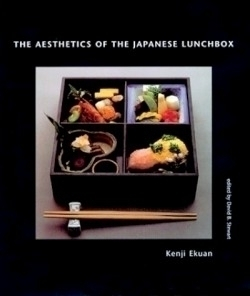The Aesthetics of the Japanese Lunchbox
This beautifully designed and illustrated book will challenge the average linear-thinking reader, who may find the author’s poetic
and at times esoteric “global” approach overwhelming. But perseverance will be rewarded.
Written by Japan’s foremost industrial designer, Kenji Ekuan, this book is an exploration of Japanese aesthetics—the harmonic blending of functionality and subtle beauty. In the makunouchi bento, or traditional Japanese lunchbox—a lacquered square box subdivided into four quadrants, Ekuan finds a metaphor for things Japanese. Describing the box’s ordered compactness and assortment of commonplace foods from the land and sea, Ekuan writes, “I can not help but consider the lunchbox as virtually an emblem of the land itself.”
In the box’s exquisite arrangement of textures, flavors and colors, Ekuan discovers connections with the Japanese landscape: a narrow slice of mountains and plains squeezed on all sides by a lapping sea.
The makunouchi bento literally means intermission and was developed for theatergoers in Japan’s Edo period (1603-1868). Within each of its compartments there are four to six types of food bringing a total of 20 to 25 colors and flavors. This multiplicity within an ordered and compact structure reflects the root of Japanese sensibilities: multi-functionality and miniaturization with an overlying concern for aesthetics. Ekuan concludes that: “After a commodity has brilliantly fulfilled its function… it can still achieve beauty. These qualities can be found not only in the lunchbox, but also in many contemporary Japanese products such as the hand-held calculator, luxury compact cars, and sleek, high-tech cameras. Japanese design is one of outer reduction and inner multiplicity.”
In the last section, Ekuan offers another layer to the lunchbox’s growing metaphorical imagery, writing that, “It is a form of salvation just to come in contact with such beauty.”
But even more, the lunchbox’s ordinariness is its greatest form of salvation for in its commonplace foods and utilitarian nature we may yet live richly and with beauty.
Reviewed by
Shellie Williams
Disclosure: This article is not an endorsement, but a review. The publisher of this book provided free copies of the book to have their book reviewed by a professional reviewer. No fee was paid by the publisher for this review. Foreword Reviews only recommends books that we love. Foreword Magazine, Inc. is disclosing this in accordance with the Federal Trade Commission’s 16 CFR, Part 255.

